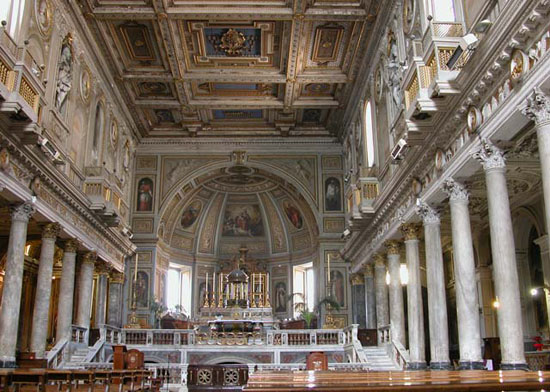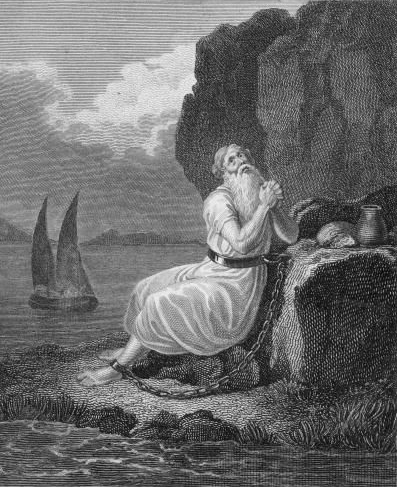

While the concourse of pilgrims to the sepulcher of St. Martin, Bishop of Tours induced his third successor, Perpetuus, to raise over his precious remains the basilica in which so many prodigies were to be wrought all through the middle ages, Rome herself was dedicating to St. Martin of Tours one of her noblest churches, uniting with him as joint titular her own illustrious Pope and Confessor, St. Sylvester. Adorned with this two-fold glory, St. Martin-on-the-Hill worthily inaugurated in the Eternal City the veneration of Confessors, side by side with that of the Martyrs. But another honor awaited this venerable sanctuary. Beside the wonder-working Bishop and apostle and the Pope of peace, both vanquishers of idolatry, who had escaped the sword only through the conversion of the persecutors, the last of the Martyr-Popes, also Martin by name, came to seek a resting-place, long after the pagan persecutions had ceased.
"St. Martin I," says Baronius, "fared better than any of his predecessors since the time of Constantine. Found worthy to suffer more than all of them for the Name of Jesus Christ, he had the good fortune to find a Decius and a Diocletian in a baptized prince."
The Emperor thus stigmatized by the great annalist was Constans II. From his grandfather, Heraclius, who at least had given the world a few years of glory, he inherited nothing but the Byzantine pretension of imposing his dogmatic edicts upon the Church. Like the Ecthesis of Heraclius, the Type of Constans aimed at silencing the Catholics in their struggle with the Monothelites. The history of St. Leo II, who feast is on July 3, has already initiated us into these contests concerning the integrity of the two Natures, Divine and Human, in the Man-God. Could the Church, without protesting, allow it to be said that Her Spouse had taken from Adam a mere appearance of humanity, a half-formed nature without a will, as these new sectaries imagined?
More clear-sighted than Honorius, Pope St. Martin I understood the danger and knew how to repair the past, while securing the future. Scarcely had he ascended the apostolic throne, when he gathered in the Church of Our Savior one of the most beautiful assemblies ever held there. "Sound the trumpet, cry out upon the mountains; soldiers of God, awake!" were the final words of its opening discourse (Mansi X, p. 870). Thus from its very opening did the Lateran Council of 649 repair the fatal silence and avenge the Church’s honor. On reading its splendid and ample definitions, which present to the world the Son of the Virgin Mother in all His adorable integrity, we are reminded of the solemn declaration in the praetorium on Good Friday: "Behold the Man!" only that this time it was proclaimed in triumph and by those who loved Him. Truly, O God our Savior, Thou art the most complete, the most perfect, the most beautiful of the sons of men.
What a solace to the mind to see the imperial decrees returned, with the qualification of wicked and impious to the Byzantine Caesar, who held the defenseless Pope at his mercy in still dependent Rome! St. Martin I, like St. Paul, could take the Church of God to witness that he had not neglected the duty of enlightening the flock; he could remind the pastors of the price at which Christ had purchased the sheep committed to their care—he himself was ready for everything (Encyclical Letter Promulgating the Council, Mansi X, p. 1178). His martyrdom was to secure the final triumph, of which the Sixth General Council and St. Leo II were destined to gather the fruits.
The Greeks celebrate on the 13th of April the feast of this glorious Pope, whom they call a "coryphaeus (leader of a chorus) of divine dogmas, the honor of Peter's See, the Pontiff who maintained the Church unshaken on the divine Rock."
The Roman Church gives this brief account of him in Her Liturgy:
St. Martin was born at Todi in Umbria. Upon ascending the pontifical throne, he strove by letters and embassies to recall Paul, Patriarch of Constantinople, from his wicked heresy to the true Catholic Faith. But, supported by the heretical emperor Constans, Paul was so carried away as to exile the legates of the Apostolic See to various islands. The Pope, indignant at this outrage, summoned a Council of 105 Bishops at Rome, in which he condemned Paul.
Upon this Constans sent the exarch Olympius into Italy, with orders either to kill Pope St. Martin, or to bring him to the emperor. Olympius, on reaching Rome, charged an executioner to assassinate the Pope as he was celebrating Mass in St. Mary's at the Crib. But the man, attempting to do so, was suddenly struck blind.

If it is just that the human race should honor its members in proportion as it has been honored by them, then St. Martin I deserves a glorious memory. For not only were his wonderful virtues such that they cause the very powers of Heaven to admire our earth, but he likewise compelled Satan to humble himself before our human nature. Deified entirely in the Person of God the Son, it is through him that it was fully recognized as such, in spite of contradictions, in spite of the powerful ones of this world leaguing with the spirits of wickedness to overcloud this incomparable nobility of the sons of Adam.
How comes it that man is ever ready to join hands with Satan for his own destruction? But Lucifer at first was himself his own only enemy; and surely his folly is more difficult to explain, than that of the frail creature he strives to draw after him along the path of pride which led him to perdition. It is pride that made him the prince of folly and father of lies. His intellect, though the loftiest in Heaven, was not proof against self-love, which induced him to take complacence in his created nothingness, to detain the truth of God in injustice (Rom. 1: 18), and to prefer darkness to light. Thus it is that men, following Satan's example, and dishonoring God to exalt themselves, become vain in their thoughts (Rom. 1: 21), till such a darkness comes over their mind and heart and senses, as strikes with astonishment the soul that remains simple and upright in its humility.
Protect us then, O holy Pontiff! Keep up in us the understanding of God's gift. May we never deserve the reproach of the Psalmist: Man when he was in honor, did not understand; he is compared to senseless beasts, and is become like to them (Ps. 48: 13). May Eternal Wisdom, to Whose alliance we are called, never have the grief of seeing us prefer darkness and the death of the soul. At the same time, teach us that, for the honor of God as well as of man, the integrity of Our Lord's Incarnation does not require the authentication of politicians, nor the approbation of the would-be wise; for it is of this Mystery the Apostle says, that we must believe it with the heart in order to become just, and confess it with the mouth in order to be saved (Rom. 10: 10). Spare the Church the sorrow of ever again finding Herself in such a situation as that from which thy heroic martyrdom was alone able to deliver Her; or obtain by thy prayers such fortitude for Her members, as may enable them to endure such a martyrdom as thine.
Contact us: smr@salvemariaregina.info
Visit also: www.marienfried.com